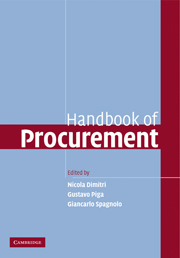Book contents
- Frontmatter
- Contents
- List of figures
- List of tables
- List of contributors
- Preface
- Part I Preliminary Issues
- Part II General Strategic Principles
- 3 When should procurement be centralized?
- 4 Procurement contracting strategies
- 5 Incentives and award procedures: competitive tendering vs. negotiations in procurement
- Part III Competitive Tendering Strategies
- Part IV Attracting and Screening Participants
- Part V Preventing Collusion and Corruption
- Part VI Dynamic Forces and Innovation
- Glossary
- Index
- References
3 - When should procurement be centralized?
Published online by Cambridge University Press: 04 November 2009
- Frontmatter
- Contents
- List of figures
- List of tables
- List of contributors
- Preface
- Part I Preliminary Issues
- Part II General Strategic Principles
- 3 When should procurement be centralized?
- 4 Procurement contracting strategies
- 5 Incentives and award procedures: competitive tendering vs. negotiations in procurement
- Part III Competitive Tendering Strategies
- Part IV Attracting and Screening Participants
- Part V Preventing Collusion and Corruption
- Part VI Dynamic Forces and Innovation
- Glossary
- Index
- References
Summary
Introduction
Technological and organizational innovations can make it possible to have more cooperation and more initiative simultaneously. Information technology is an obvious source of such movements. By allowing finer performance measurement and better communications, it facilitates getting more initiative (through lowering the cost of providing incentives) and more cooperation (by making coordination easier and increasing contacts among units).
(Roberts 2004, p. 112)Motivated by the need to control costs and streamline processes, the issue of centralization versus decentralization has captured the interest of researchers, practitioners and public administrators from a variety of perspectives and is becoming increasingly important for many organizations. An efficient procurement policy is arguably one of the key activities in private companies, international institutions and governments. In this chapter we discuss purchasing systems from the specific point of view of their degree of centralization.
Given the considerable volume of resources involved, firms and governments always seek to optimize procurement so as to deliver value for money to business units and taxpayers. In pursuing such a goal often the first important choice is to choose between centralized and decentralized purchasing; profitability, performance and budget control within a private company or a public institution can vary considerably according to how purchases are organized and managed.
- Type
- Chapter
- Information
- Handbook of Procurement , pp. 47 - 81Publisher: Cambridge University PressPrint publication year: 2006
References
- 26
- Cited by

